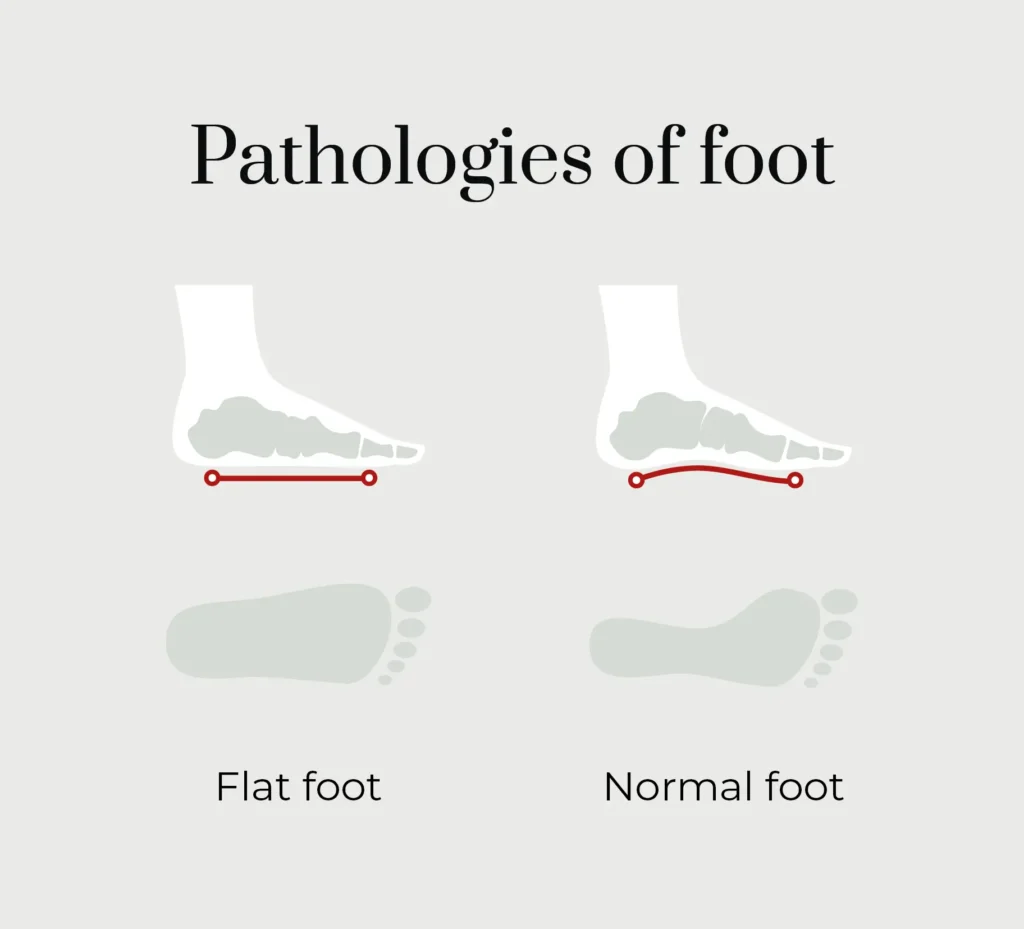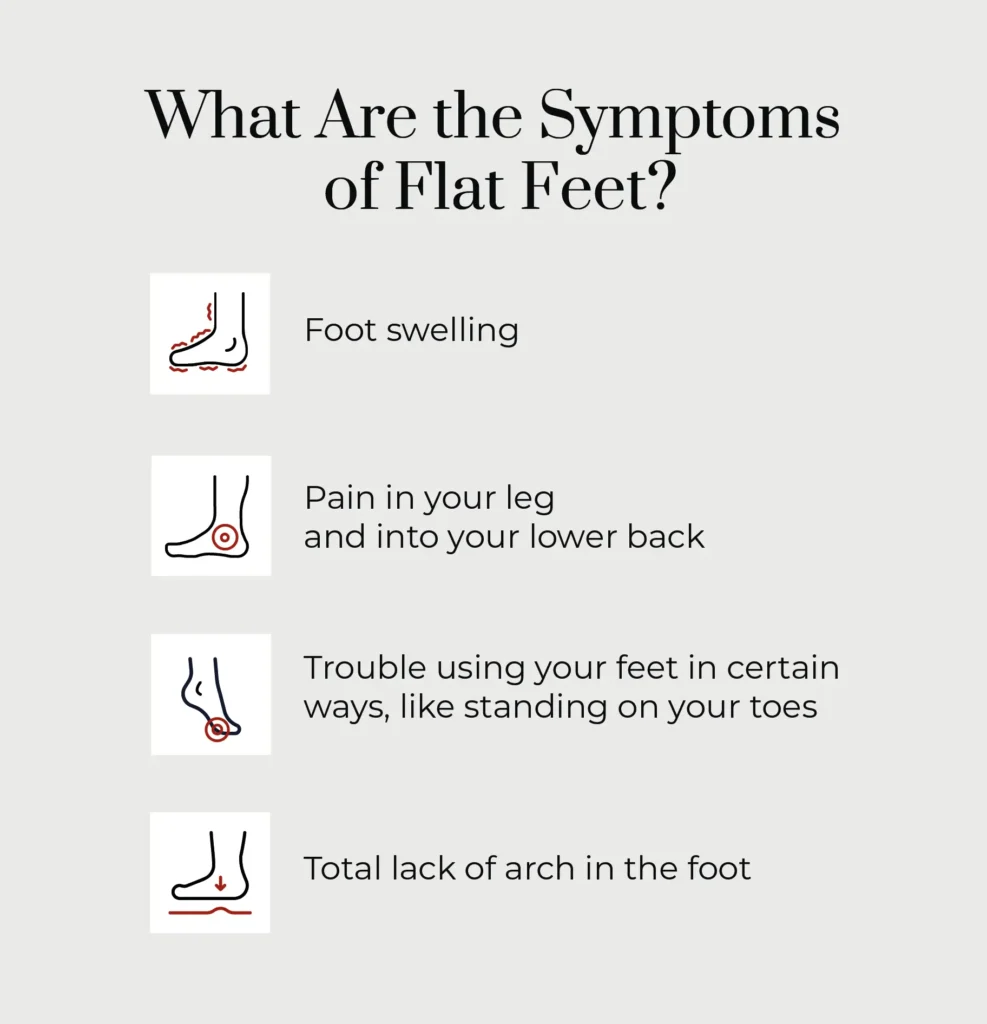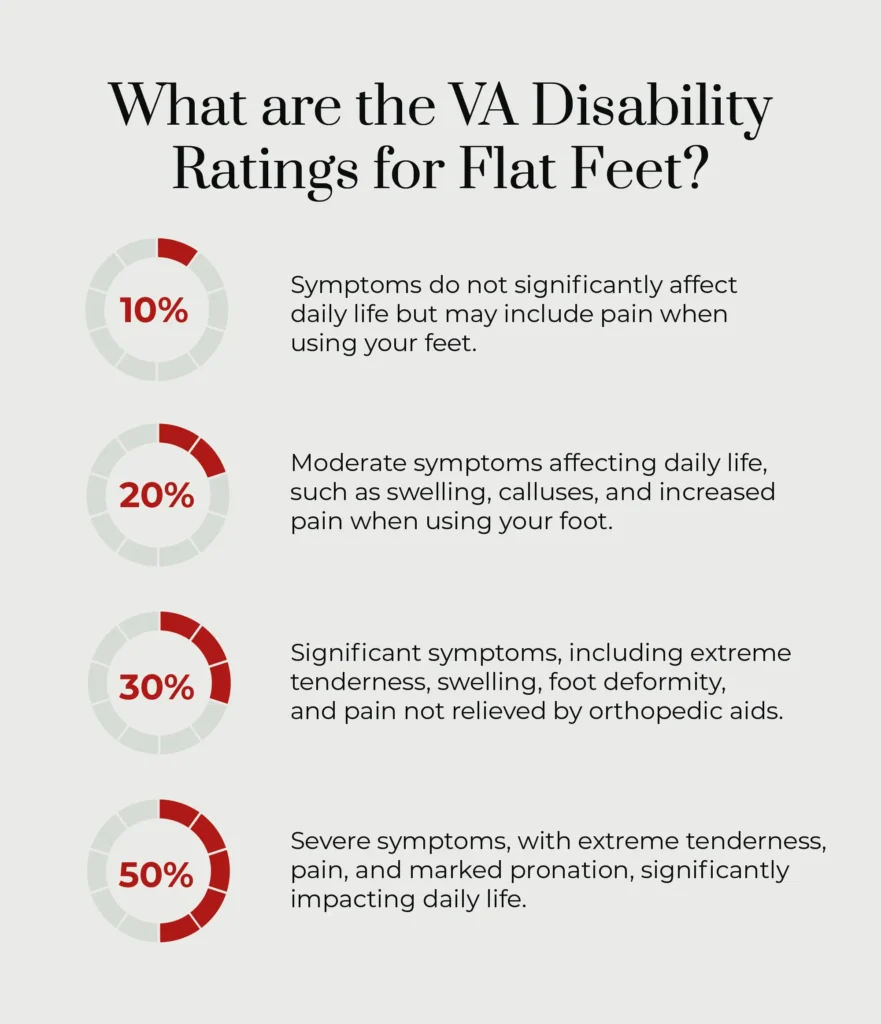The condition known as flat feet (or “pes planus”) is one that is common in both citizens and veterans of active duty military service. The U.S. Department of Veterans Affairs (the VA) assigns disability ratings ranging from 0 to 50 percent for military veterans who have a flat foot condition that arose during their military service or which became worse because of such service.The Stone Rose Law firm assists veterans with disability claims for flat feet. Whether you are making an initial benefits claim, or a secondary claim on top of an existing flatfoot disability, or if you need to appeal a VA claim denial, our experienced VA disability lawyers can help. Call us at (480) 498-8998 to speak with one of our veterans’ disability law specialists and to set up a free initial consultation to review your claim for benefits related to flat feet.
A flat foot deformity exists when the arch of the foot basically does not exist. A classic symptom of flat feet is when the entire sole of the foot comes into contact with the ground when you are standing or walking.
Flat feet are often a minor condition that causes no pain. But if you engage in activities common to military service—like standing or walking for prolonged periods in footwear like combat boots, carrying heavy loads, and running for long distances—then flat feet can become painful.
Flat feet symptoms that worsen over time can lead to a domino effect that can affect your ability to work and engage in daily life activities. For example, if your flat foot condition causes you to experience pain in your hips or lower back it can be hard or impossible to perform your job duties or even make it hard to walk.

You can have flat feet for several reasons.
Some you may have no control over, like a family history of flat feet that you inherited from your parents, from a birth defect, or poor foot mechanics. Flat feet are also more common in children whose muscles in the arches of their feet are still developing.
In other situations, you can develop acquired pes planus after a foot injury dislocates or breaks a bone in your foot, otherwise weakens the muscles of your foot, or tears or stretches tendons in it.
Another potential contributor to flat feet that veterans can suffer from is rheumatoid arthritis.
Most of the time, veterans who experience flat feet have symptoms mild enough that no treatment is needed.
In more serious cases of flat foot deformity, however, you might experience foot pain and any of the following symptoms:

Another medical condition affecting the feet that veterans frequently experience is plantar fasciitis. This condition can occur when the soft tissues that connect your heel to your toes (the plantar fascia) become inflamed.
Plantar fasciitis mainly affects your heel. Its main symptom is pain that can become worse if you engage in the same common service-related activities that can aggravate flat feet. Also, having flat feet can make you more prone to developing plantar fasciitis.
You make an initial VA claim for a flat foot condition filing for the disability on VA form 21-526EZ.
To obtain service connection for flat feet, you must show:
Your diagnosis from your primary care doctor or from a podiatrist or your VA medical records.
You will need to be able to support with adequate documentation your disability claim for flat feet sufficient to establish a nexus between your military service and the onset of your disability. You will usually do this with your medical records of diagnosis and pes planus treatment, supporting written statements from coworkers, family members, and others who can attest to how your flat feet have affected your life.
In addition to this evidence, the VA will often require you to attend a compensation and pension (C&P) examination.
At a C&P exam, a VA examiner will review your past medical history, ask you questions about your condition, and will usually have you go through a physical examination to assess your symptoms. The exam will look for issues, including pain, swelling, tenderness, and the presence of calluses. It may also include a walking test or require you to undergo x-rays of your affected foot or feet.Tip: If you are experiencing painful pes planus symptoms and are taking pain medications for them, do not take those medications on the day of your C&P exam. Pain symptoms are important in calculating your VA disability rating for flat feet, and your VA examiner will need to accurately assess yours without them being masked by pain medications.
Here are some specific things your VA examiner will check for as part of your C&P examination:
If the VA approves your application for VA disability benefits for flat feet, then the next step will be for the VA to assign you a disability rating. Your VA disability rating for a flatfoot deformity can be from 0 percent to 50 percent, with intermediate ratings of 10, 20, and 30 percent in between.
When assigning your Pes planus va rating, the VA uses three criteria: how severe your flat foot condition is, what your symptoms are, and how the condition affects your daily life. Based on this comprehensive assessment, here are the ratings you might receive.
A rating of 0 percent means that the VA estimates that your flat foot condition has no symptoms, or has only a minimal effect on your daily life and can be treated with proper footwear like motion-control shoes or arch supports.
Although a 0 percent disability rating does not qualify you for VA monthly disability compensation payments, it does give you access to other VA disability benefits including access to VA health care facilities and treatment and other benefits.
At this level, your symptoms do not yet significantly affect your daily life but they can include pain when using or manipulating your feet.
The VA has a policy that if you are experiencing pain because of a disability like flat feet, then you should receive at least a 10 percent disability rating. This is known as the Painful Motion Principle, which is that if pain is present then you should receive at least the minimum compensable disability rating for that condition.
The 20 percent disability rating means that your symptoms are having a moderate impact on your daily life. These symptoms can include swelling when you use the affected foot, the presence of calluses, and increased pain when walking, standing, or manipulating your foot.
The 30 percent disability rating is for flat feet the symptoms of which are significant symptoms that have a substantial impact on your daily life. These symptoms can include extreme tenderness, calluses, swelling, foot deformity, and pain that is not improved by the use of orthopedic shoes, inserts, or other appliances.
The 30 percent disability rating is where the VA begins to distinguish between a flat foot condition that affects one foot (a unilateral pes planus condition) and one that affects both feet (a bilateral pes planus condition).
The 50 percent disability rating reflects a state where your flat foot condition is manifesting severe symptoms that are having a significant impact on your daily life, with extreme tenderness, pain, and marked pronation.

VA ratings for plantar fasciitis range from 10 percent to a maximum of 40 percent, depending on factors like whether one or both feet are affected, whether surgery or non-surgical treatment options will treat the condition, and whether you have lost the quality use of a foot.
The VA does not often assign disability ratings for both flat feet and plantar fasciitis because their symptoms, most notably pain, tend to overlap. This means that the VA will be careful to avoid awarding two disability ratings for the same symptoms in an affected foot, an outcome the VA refers to as pyramiding.
In cases where both flat feet and plantar fasciitis are present, what the VA will usually do is award the higher of the two applicable disability ratings.
To learn more about how multiple disabilities can be combined into one rating, and how an acquired flat foot deformity can factor into it, see our VA Disability Calculator page.
Sometimes the VA declines to approve initial applications for benefits. If this happens to you in your claim for flat foot disability benefits, this is not the end. You have multiple options to either re-file your claim with new and relevant evidence (a supplemental claim), ask for a high-level review of your application, or make a formal appeal to have a VA law judge review your case.
Each of these approaches has its advantages. An experienced veterans’ law lawyer can help you decide which option is best for you in your unique circumstances.
At Stone Rose Law, we are board-certified VA claims lawyers who serve veterans nationwide. Our VA-accredited attorneys give you affordable, high-quality veterans appeals legal assistance.
Our veterans lawyers provide highly professional legal representation to military veterans, helping them through the VA process to receive all the veterans’ disability benefits they are entitled to.
A Stone Rose disability lawyer can help you prepare your pes planus or plantar fasciitis disability claim, monitor your claim status, and consult with you before disability examinations—all at no cost to you.
If the VA denies your initial benefits claim, then our VA benefits law firm will assign a VA disability appeals lawyer to help you pursue a VA appeal with the Board of Veterans Appeals while providing free representation on a contingency fee basis.
This means you won’t pay your VA disability lawyer any fees unless we win your appeal. For more information about how one of our VA disability lawyers can help you with your VA disability compensation claim or appeal, request a free assistance consultation at (480) 498-8998. Or, if you prefer, you can reach us online to ask a question about veterans’ law, veterans’ disability benefits, or to set an appointment with one of our veterans’ lawyers for a free case evaluation.